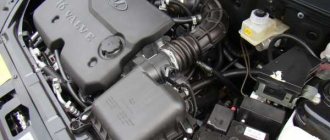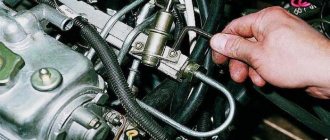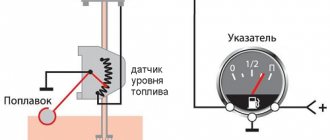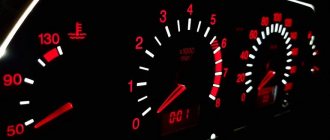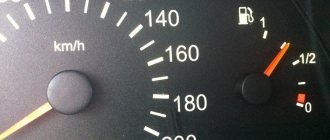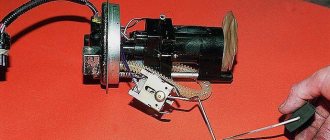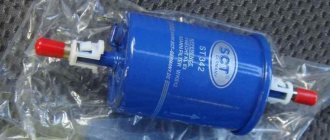Is it possible to fill up with 95 gasoline if I drive on 92?
Is it possible to fill up with 95 gasoline if I drive on 92? Now I will have to drive about 380 km along the highway there and back during the night. Is it possible to fill up with 95 gasoline if I always drive on 92. Well, the same about 98 or 92 pulsar and others. VAZ 2114 8kl 1.5l. And will this make any sense other than overpaying for fuel?
There won’t be anything worthwhile about the cream of overpayment right now, gasoline is just crap, it makes no difference that 92 or 95 is one dick, both of them are bad and their actane numbers do not correspond to their brand, it’s 100% I fill up at Rosneft, having tried to fill up with 95 it’s even worse ((( and smoke the black one came from Glushak
You can fill in at least 98 and nothing will happen. But I advise you to switch the stock engine to 95 and drive it constantly. The difference in price is not so great, but in the end you will understand that driving a 95 is cheaper than driving a 92
Summarize
And so, taking into account the above, we can say with complete confidence that it makes no difference what kind of gasoline to fill the VAZ 2114 with - 95 or 92. After all, both in terms of fuel consumption and the effect on the wear of machine parts, both of these brands perform almost identically.
If it is possible to actually fill the car with 95 (and this is proven by measurements, and not by the name of gasoline at the gas station), then it is better to fill it in the summer or when driving outside the city. And 92nd, in turn, should be filled in in winter or during city trips.
Experts poured AI-100 into a Lada engine and were surprised by the result
9 July 2022 15:00 26
By the end of the year, Gazpromneft will refuse to sell 98-grade gasoline. At the pumps where it is currently available (400 gas stations throughout the country), it will be possible to buy AI-100.
— For three years, the “hundredth” G-Drive has been sold at our stations in Eastern Europe, where it has gained great popularity. We are glad that now Russian motorists will be able to appreciate this high-tech fuel, feel the full power of their car and get maximum driving pleasure,” the Gazpromneft gas station network commented on the news.
We are also glad that drivers in Eastern Europe appreciate domestic gasoline. But half of Russia drives Ladas of different vintages. Will high-octane gasoline benefit ordinary drivers?
The answer to this question was obtained in the laboratory of South Ural State University. Experts tested G-Drive 100 gasoline on a VAZ-21114 engine (installed on VAZ 2110, 2111, 2112 models). Almost a third of the country’s entire passenger car fleet now drives with such engines.
What we found out:
— AI-100 does not harm the “tens” engine in any way.
— Detonation does not occur even at the highest speeds.
— Burnout of valves was not noticed.
— “100th” gasoline reduced fuel consumption (compared to AI-95) in all engine operating modes.
— Almost no carbon deposits are formed.
Pavel Kartashov, technical expert of the international company APL, commented on the results obtained.
— Each driver experiences driving modes when the likelihood of detonation is increased: lifting, acceleration, and so on. Under these conditions, high-octane gasoline will allow the engine to run more smoothly. Detonation either will not occur or will appear later. And one more thing: all engines have deposits in the combustion chamber; they appear after 15-25 thousand kilometers. Deposits change the combustion conditions of gasoline and contribute to detonation.
Kartashov explained that deposits interfere with heat transfer through the walls of the engine. Because of this, the combustible mixture in the cylinder heats up more, and this already leads to detonation.
“On used engines, it is recommended to use gasoline with an octane number increased by 3-5 units or more,” the expert added.
And yet, for which vehicles is the AI-100 suitable?
For everyone who has no upper octane limit. If it says: no less than 92 or 95, then you can safely say “hundredth”. The engine will only be better for it.
But if the manual clearly states: from 92 to 95, then high-octane fuel will not work.
G-Drive 100 gasoline is produced at the country's largest oil refinery in Russia in Omsk (owned by Gazprom Neft). After modernizing the installations, refineries can directly produce “100th” fuel. It does not contain any octane-boosting additives, which means AI-100 is safe for cars.
Now “100th” gasoline is transported by rail from Omsk to the country’s oil depots. From there they are delivered on fuel trucks to the gas stations of the Gazprom Neft network.
WHAT IS DETONATION AND OCTANE?
The octane number shows the ability of gasoline to resist detonation. With proper combustion of fuel, the flame front moves along the cylinder from the spark plug at a speed of 30-60 m/s. Everything develops smoothly, calmly, predictably.
But if somewhere (usually in the part of the combustion chamber farthest from the spark plug) explosive self-ignition of the fuel occurs, then a detonation wave rushes towards the normal flame front. Its speed can exceed 330 m/s.
For an engine, such abnormal explosions in the cylinder can be disastrous - detonation leads to burnout of valves, destruction of pistons, and the appearance of scoring on bearing liners.
Pavel Kartashov, technical expert of the international company APL:
“The first gasoline with an octane number of 100 appeared during the Second World War,” said Pavel Kartashov. — Further, the development of automotive technology and the development of oil refining technologies went parallel to each other. As a result, engines with high compression ratios appeared, which required high-octane gasoline. High-octane gasolines are currently used for cars with powerful turbocharged engines, for cars with a high compression ratio. But even the most ordinary modern car is increasingly calibrated for high-octane fuel, so the consumption of high-octane gasoline is growing more and more.
Advice from motorists
Often, car owners try to listen to the advice of other drivers, including on the issue of how to refuel a VAZ 2114. True, the advice here is radically different - one half drives a 92 and praises it, the other is in favor of a 95, because that’s what’s written in the passport and this is right".
In such a situation, it is worth recalling the above phrase once again - a difference of 3 octane units is quite insignificant and is poorly perceived by both the car and its driver (in the latter case, most opinions like “better are subjective”). An objective assessment here could be fuel consumption or the degree of wear of some elements, but they are almost the same (of course, there is a difference, but it is very small).
Sixteen-valve engine 1.6 model 21124
Developing the line of successful 1.6 engines, in 2009 a 16-valve modification 21124 with direct injection and manual transmission was offered. This power unit develops 90 horsepower, accelerates the car to 100 km/h in 11.2 seconds, with a maximum speed of 185 km/h. At the same time, fuel consumption 2114 per 100 km became lower:
- city mode 8.2 l;
- average 7.6 l;
- on a free road 7.2 liters.
Feedback data
- Vladimir, Velikie Luki. My VAZ 2114 2010 with a sixteen-valve 1.6 with 90 horsepower for a taxi. I made no mistake in my choice - a reliable, roomy, economical car with measured driving. During this time, the chassis had to be repaired more than once, but the engine performed well, and didn’t even start taking oil. Even in winter, consumption does not exceed 9.5 liters, on the highway at 110-120 km/h about 6 liters, you start driving more, your appetite increases abruptly. At one time, the fuel consumption on my VAZ 2114 increased, but after checking the condition of the injectors and cleaning them, everything was restored.
- Alexey, Vologda. I learned on this car, I borrowed it from my father. I've driven more than 90 thousand km - it's a very good car, the 1.6 engine with 90 horsepower is unpretentious and reliable, it pulls well. It holds the road well, but feels good on the ground and on city streets. Fuel consumption per hundred is from 9 to 7 liters.
- Nikolay, Kaluga. I have owned the car for more than 10 years, and I consider it a good option for a family with two children. A universal option for trips to the shops, to school, to nature or to the countryside. I drive carefully, so on the highway the gasoline consumption is 5.5 liters, in traffic it increases to 8 liters, which suits me quite well, and I’m not going to change my VAZ 2114 yet.
- Anatoly, Omsk. I needed an unpretentious car, an option that was cheap to maintain and repair. VAZ 2114 with a 1.6 engine with 90 horsepower fully satisfied my needs. Fast and passable, there have been no serious problems the entire time, at speeds above 120 km/h the consumption is about 8 liters, but in economy mode you can keep within 5 liters.
- Denis, Perm. The 2114 is very popular with us; I bought a used car for driving out of town, hunting and fishing. I installed all-season tires, now the car is not afraid of dirt and potholes. The suspension is elastic and reliable, there were no problems with the gearbox. Timely replacement of filters and oil guarantees the reliability of the 1.6 sixteen-valve engine, consumption in heavy traffic is up to 9 liters, and on the highway 7.
Engine 1.6 model 21126
In 2010, the popular 1.6 engine with sixteen valves was modified, as a result of which it began to produce 98 horsepower, accelerating the car to 190 km/h, and to the first hundred in 11.2 seconds. Gasoline consumption of this modification:
- heavy traffic 9.5 l;
- mixed cycle 7 l;
- highway 5.4 l.
Real consumption
- Igor, Moscow. A universal option for city and country trips. The 1.6 engine with a manual transmission is very reliable, responsive and unpretentious. Measurements showed that the consumption practically corresponds to the passport value. On the highway, 5.5 liters of AI 95 are consumed per 100 kilometers; in the city, even in winter, no more than 10.
- Yaroslav, Kharkov. I consider the VAZ 2114 one of the most successful cars, but it requires timely maintenance, especially the 1.6 engine with 98 horses. The transmission and chassis are very reliable, consumption does not exceed 9 liters, in a circle it turns out to be about 7 liters per hundred.
- Stepan, Kazan. I bought a new car in 2010 with a 1.6 engine. Initially, I was worried about the consumption - in the city it reached 12 liters, I was looking for the reasons for the high fuel consumption in my VAZ 2114, but after the run-in everything fell into place: 9 in traffic jams and 6 on the free road, even if driving energetically. Comfort is a little weak, but otherwise a very good car - reliable, dynamic, inexpensive to maintain.
- Ivan, Ryazan. I bought a VAZ 2114 in 2010, during which time I can say that the money was well spent. The car pulls excellently, it is reliable and easily digests 92-octane gasoline. The suspension is ideally adapted for our roads, the mechanics do not cause any complaints. Consumption is also pleasing - in the urban cycle it does not exceed 10 liters, and on the highway you can easily keep it to 6.
- Boris, Smolensk. I often travel to Minsk for work, so I need a reliable and economical car. The VAZ 2114 with a 1.6 engine producing 98 horsepower met these criteria, and for quite reasonable money. Fuel consumption on the highway is about 6 liters, I drive around the city less often, here you will need up to 9 liters per hundred.
What happens in the gas tank
It is for this reason that car enthusiasts like to fill their gas tank with equal amounts of both types of fuel, because they believe that they have managed to combine a low price, good engine response, and all this on relatively pure gasoline. However, different grades mean not only different octane numbers, but also different fuel densities. Knowledge of the simplest laws of physics tells us that the denser and heavier 92- will sit at the bottom of the fuel tank. At the same time, the lighter 95 will tend to move up. Hence the conclusion:
Both fuels will be consumed alternately, with little actual mixing occurring.
If this is so, then it is unlikely that it will be possible to achieve a particularly significant improvement in the characteristics of the power unit. On the other hand, we can talk about small savings, which are unlikely to exceed a few percent. But for particularly scrupulous drivers, this may be important, because instead of pure 95, we partially fill it with fuel with a lower octane number.
Replacement frequency. Influencing factors
First, the oil change in the VAZ 2114 engine is carried out based on the mileage that the car has traveled. Each car owner decides for himself when it is time to change the lubricant. But the experience of the owners of the fourteenth model, as well as the advice of professionals, gives a hint that it is better to change the oil approximately every 10-15
Removing the oil filter
There are a number of reasons that can affect the frequency of replacement:
- Current condition of the car;
- Engine wear level;
- The quality of the previously used lubricant for the unit;
- Conditions in which the vehicle is operated;
- Seasonality of car operation;
- Driving style.
Lambda probe
The oxygen sensor in 2114 is an unreliable element. Its malfunction affects the stability of the engine. When the lambda probe breaks down, the engine at idle starts to work with dips. Its malfunction is first indicated by a check on the dashboard. The built-in self-diagnostic function also allows you to determine the error code. Replacing the lambda probe is done by yourself. You can continue driving if it breaks down, but this will increase consumption.
Ignition module
The appearance of microcracks in the ignition module housing is a common occurrence. Poor quality plastic, which shrinks under the influence of temperatures, leads to the appearance of cracks. Insufficient spark power reaching the wires, and then to the spark plugs, leads to the problem of improper ignition of the mixture. In case of such a malfunction, the check also lights up.
You should not try to glue microcracks, because... they will appear again when exposed to temperature. Replace the ignition module and reset the errors. If there are breakdowns, check the condition of the wiring to the module and the condition of the chip.
A malfunction of the module not only causes high gas consumption, but also leads to “tweaking” of the engine, which can lead to rapid wear. Malfunctions in the spark supply system conceal a lot of problems: decreased dynamics, the appearance of lumbago, contamination of the combustion chamber of the mixture due to the lack of a spark, etc.

